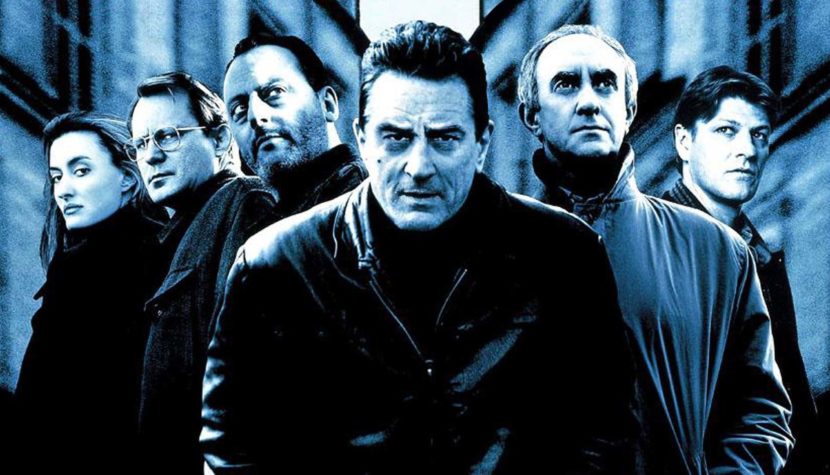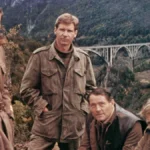RONIN. Not another mindless blockbuster

In the last decade of the previous century, the shape of the cinema begun to suddenly change. The entire new generation of filmmakers started to craft movies in their own form and style – mostly fast, with a lot of cuts, over the top action, slow-motion and heavy beats in the background, ‘pretty’ filters and CGI tricks, which made them look more like commercials or music videos, on which their directors’ experience was based anyway. Starting with True Romance (1993) by a veteran Tony Scott, Speed (1994) and, most notable, Bad Boys (1995) the new, ‘cool’ face of the action genre arose. And the old masters slowly commenced to fade away. As if along with the fall of one system, something else had fallen also. Stallone, Schwarzenegger, Van Damme and most of the other notable stars were forced to reinvent themselves, with various results. And many of those careers simply crumbled by the time The Matrix (1999) hit the big screen.

It is impossible to write about Ronin without the context. After all it’s creator, one of the greatest directors of action packed films, such as The Train (1964), French Connection II (1975), Black Sunday (1977) and The Challenge (1982) – John Frankenheimer – passed away soon after, making the death of an entire era somewhat official. Thus his last notable motion picture became the last action film in it’s finest, purest structure and, quite possibly, remains as one of the best ever made too. It is so ‘old school’ in so many ways, it was considered vintage even during the principal photography, in fall 1997.
Lensed by Robert Fraisse, edited by Antony Gibbs and shot partially in Paris – favourite city of Frankenheimer, who lived there quite a long time and was fluent in French – Ronin was literally a blast from the past. In the times when Hollywood was beginning to choke with progressing computer animation, PG-13 ratings and enormous budgets growing like a weed, Frankenheimer took his crew and stellar cast to Europe and did everything his way. The right way. The only way he knew how to do it. And he did it for only fifty-five million dollars (sadly, like many other classically made movies from the 90’s, it was a box office flop).
Shot with multiple cameras almost entirely on location, on real streets with real people and real cars (and, if anyone cares, during real weather), Ronin was based fully on good ol’ stunts, pyrotechnics and skills of the professional drivers – over 300 of them (!!!), some even former Formula 1 members. And luck, of course. Plenty of it. Watching all those wild car chases, that made Ronin legendary, one can wonder, how come not even a single accident occurred on set? Why absolutely no one got hurt or even scratched? After all there’s no hiding behind CGI (well except of one scene with obvious green screen in it – ironically, it’s a conversation piece), no extra protection whatsoever, and no turning back.

Just like William Friedkin in the first French Connection (1971), Frankenheimer – former amateur racing driver himself, and a man, who thirty years earlier made breakthrough technical masterpiece Grand Prix (1966) – just went for it. Every chase scene in this two-hour rollercoaster ride was done in real-time, at very high speed – in exact way as we see it on the big screen, with no image alteration in post-production, like in the case of praised Mad Max: Fury Road (2015). And not only with paid for taking such risk drivers in every car, but with main actors sitting next to them as well! Major stars with no stunt doubles – unless your name is Cruise, it’s an impossible mission nowadays! Considering that 80 automobiles were destroyed during filming – among them brands like Audi, Peugeot, Citroën, BMW and, director’s favourite, Mercedes-Benz – this is a truly metal-crunching realism. It’s honest. And it works. It makes you believe.
But believe in what exactly?
Related:
The true beauty of "Ronin"
Now there lies a true beauty of Ronin, since it’s whole story (crafted by J.D. Zeik) is very deceitful (which shouldn’t be much of a surprise, considering that the script was polished by master of fraud himself – David Mamet, under the false name of Richard Weisz). Or simply it is not so obvious at first. The late Roger Ebert wrote once that this movie „is not really about anything”. And in a way he was right – it is a well crafted lie. A one big stunt.

The entire plot evolves around yet another, and one of the most famous examples of McGuffin (those of you, who still don’t know what it is, should ask uncle Google) – a silver case that has to be snatched from bad guys, at any price, by our crew of mercenaries (Robert De Niro still feeling Heat around the corner, Jean ‘Leon’ Reno, Natascha McElhone freshly out of The Truman Show, great Stellan Skarsgård caught during his involvement with Lars von Trier, the one and only Sean Bean, and relatively unknown to the wider audience Skipp Sudduth, who, by the way, did nearly all of his own driving in the film).
Just like in Pulp Fiction (1994), we never find out what’s inside this mysterious, shiny baggage. And neither does our heroes. However, unlike Quentin Tarantino’s pop-culture mash up, where nobody cares anyway, in Ronin the question is actually asked out loud – by De Niro himself. Yet there’s no direct answer. They risks their own lives and kill each other over it (body count: 34), in between takes throwing clueless references to some “man in the wheelchair” (from The Bourne Identity book, which modern adaptation is just few years ahead), but the content remains some sort of an open secret.

Podobne wpisy
Still, as De Niro said once in other cult action flick mentioned above, there’s a flipside to that coin. The case itself and what’s in it doesn’t really matter. What matters is every other thing in the (constantly moving) picture, and the fun that the entire business brings along (to the audience at least). To put it simply: when, who, how and, lastly, most crucial – why? I don’t want to spoil that last one – even though Ronin celebrates it’s 20th birthday this year (!!) – so let’s just say everything lies within. Even the poetical title, which is followed by quick ‘know-how’ intro and later on explained more thoroughly with some help of samurai miniatures (director’s passion) and the great Michael Lonsdale in the small episode. You just have to always pay attention to detail, subtext, and contrast, since Frankenheimer simply (and very, very smoothly) throws you from one scene to another, many times without any given information of any kind.
For instance, did you know that this is in fact a Christmas movie? Not Die Hard Christmas like, but the setting is there. It’s just not that evident at first glance. And there’s not much time to give such details much thought also. Constant transitions are even in the quiet scenes; Frankenheimer uses plain and simple shots, no slow-motion. Everything what happens here, happens fast – not only absolutely perfect car chases and random violence (very mild for an R-rated movie), but also the unexpected romance, the dialogues and interactions between the characters, even their movement between the locations. The arrangement of whole elements within one frame is so perfectly done, that you can see everything without seeing anything at all. Or you see it, but ignore it – like Skipp Sudduth in the opening bar sequence, smoking next to a no-smoking sign. And the staff lets him, because his presence there is sort of taken for granted. It has a purpose. So we, the audience, endorse it too. Even if we do notice.
Not another mindless blockbuster
Frankenheimer goes even deeper in making this spy-thriller as true as it can get. The plot itself makes little sense if you think hard about it (however it’s not dumb like most action films of that time). But the entire backdrop and complete set of tricks of the trade give it almost a Shakespearean significance in terms of drama, passion and emotions that it brings. The entire first act welcomes you with wet surface, quiet silence and muted colors, removed entirely not only from the clothes of every person you see (even in the far background), but from the streets and objects as well. Compiled with Elia Cmiral’s wonderfully melancholic Ronin theme played with an Armenian duduk, this makes for a very sad and hopeless context.

And even when the action moves to a sunny Nice, where colors get more vibrant and alive, the mood remains cold and dead serious. Yet far from stiff. Since the very beginning the filmmakers make it obvious, that this isn’t just another mindless, overdone blockbuster filled with one-liners. So when occasional humour arrives, it seems charming at best, but never truly funny. There is nothing here to laugh about, when the stakes are so high, no one seems to know, remember or simply give a fuck anymore about what the actual prize is. They just want to get it. Along with all the ghosts in it.
Podobne wpisy
And we dig it, because the real fun in Ronin comes from its guts. From the way it was created and how it merges all those ridiculous, unspoken conspiracy with gritty action, true to it’s core and sharp as the edge of a knife. It’s stylish, James Bond like silliness, comfortably sold with poker faces of an Oscar-worthy cast (which also includes Jonathan Pryce – the third 007 former villain in this team, after Bean and Lonsdale). It’s high-tech, computer stuff (now, of course, a bit dated), non-stop racing and shootouts put next to ice-skating performance of Katarina Witt herself. It’s cool moments, like Bobby De Niro blowing up the car with a bazooka at full speed, mixed with moments of cool, such as when he conducts his own operation of gunshot wound. It just fits. And it fits so flawlessly, that even possible appearance of Ron Jeremy could not ruin it (apparently his scenes were deleted)…
It seems foolish, but when you think about Ronin from certain, less obvious perspective, one more thing that comes to mind is that it was not only a swan song of its kind. It was also last honestly good and essential role of De Niro, who soon after started mocking his own iconic image in Analyze This. Yes, he later did The Score with Marlon Brando, for whom it was a farewell performance as well (and right now he’s finishing the long awaited The Irishman), but it was pretty much as insignificant and forgettable as Reindeer Games, which was THE last film of Frankenheimer.

Of course a good film can and should stand on its own – without any further study of it’s origins, details of it’s making, political, economical or historical background and everything that surrounds it. Fortunately Ronin is a great movie. And much more than that too. It’s a celebration of man’s passion. A pure cinema magic, adrenalin driven entertainment at it’s best and absorbing storytelling (in this case, without any story to tell after all…?). One that stays with you for a long, long time, if not for ever. It’s hard to imagine more proper finale to a gloaming twilight of the genre.





